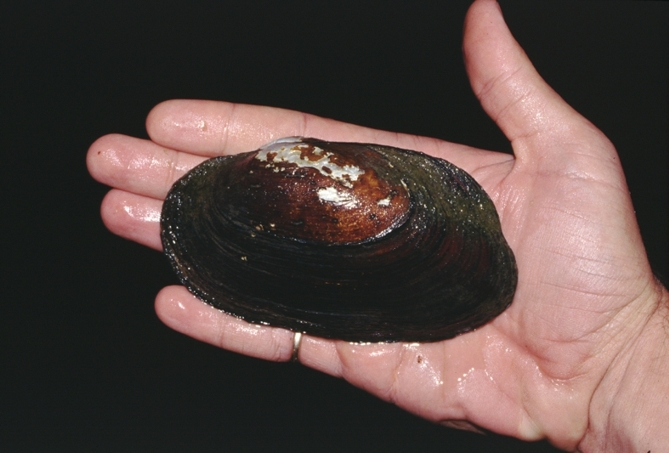Phylum Mollusca
Class Bivalvia
Order Unionida
Common name: freshwater mussels
Overview
Unionoida is a large order of moderate- to large-sized freshwater mussels with a pearly inner shell (nacre). Shells are oval to elongate and are covered in a thin, brown or blackish cuticular material (periostracum) that is often eroded around the apex (umbone) of the shell, exposing the iridescent nacreous which is frequently bluish or purplish grey colour, especially on the inner surfaces. External shell morphology can be greatly affected by environmental factors and age making generic and species level identification difficult. They use a muscular foot to drag their shell which is typically oriented horizontally at least half buried below the surface of the sediments or along the stream bed. When at rest or feeding, the shell is at least two thirds buried with hinge pointing upwards and oriented at approximately 45� from horizontal.
Distribution and diversity
Unionoida are found throughout the world with approximately 900 species in six families, two of which occur in Australasia. Unioninae is represented by a single genus, Haasodonta, which only occurs in New Guinea whereas Hyriidae are found in Australia, New Zealand, Papua New Guinea and South America. There are 17 species from six genera of hyriids found throughout mainland Australia and central-north Tasmania. Some species are widespread while others are endemic to particular catchments.
Life cycle
Hyriidae have separate sexes and males release sperm into water that enter the female via the inhalant siphon and are passed to the gills where unfertilised eggs are held. Fertilisation takes place in the gill chamber and eggs are brooded in a gill pouch (marsupia), where early larval development into a hooked larval stage (glochidium) takes place. Glochidia are released for a short time attach themselves using hooks to the fins, gills or body surface of freshwater fish or large crustaceans where they encyst and become covered by host tissue. They are not parasitic as they do no harm to their host. The glochidium stage may last from days to months, after which the almost fully developed juvenile mussel drops off with final development to adulthood taking place burrowed within the substrate. The glochidium larval stage can provide species with a greater dispersal potential.
Feeding
Unionoida are opportunistic filter feeders on zooplankton, phytoplankton, and organic detritus suspended in the water. These are are extracted from the water that is pumped into the shell by being trapped in mucous then passed by cilia on their gill filaments to the mouth.
Ecology
Hyriidae are bottom-dwellers that occur in still or running water and often are found in seasonally shallow lakes and rivers with a firm, silty mud bottom. Dry periods generally are survived by forming a cocoon in the mud. Hyridella depressa has been recorded from burrows extending to 20 meters. External shell morphology can be greatly affected by environmental factors, for example, in fast flowing waters, individuals tend to develop elongate shells whereas on gravel substrates the shells generally are heavy. Both juvenile and adult freshwater mussels are preyed upon by fish, water birds and aquatic mammals. Several species that are very restricted in their distribution, such as the Glenelg River Mussel, Hyridella glenelgensis, are considered endangered, largely due to habitat destruction and changes to water flow. Bivalves, including Unionoida are often used as biological indicators of water quality as accumulate toxic chemicals in the tissues, and hydriids, notably genus Velesunio, have been used to monitor organochlorine pesticide levels. Large species in the family Margaritiferidae (which occur across the Nearctic, Oriental and Palearctic) are cultured for the production of freshwater pearls. Nacre, the iridescent organic-inorganic composite material of the inner shell layer, known as �mother of pearl�, has been used for centuries for a range of decorative purposes.


Unionida
Image credit: Erich S. Volschenk
� Western Australian Museum

Unionida
Image credit: C. Bryce
� Western Australian Museum









